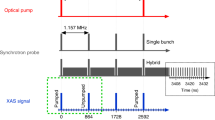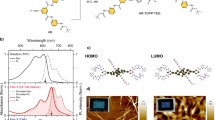Abstract
Singlet fission presents an attractive solution to overcome the Shockley–Queisser limit by generating two triplet excitons from one singlet exciton. However, although triplet excitons are long-lived, their transport occurs through a Dexter transfer, making them slower than singlet excitons, which travel by means of a Förster mechanism. A thorough understanding of the interplay between singlet fission and exciton transport is therefore necessary to assess the potential and challenges of singlet-fission utilization. Here, we report a direct visualization of exciton transport in single tetracene crystals using transient absorption microscopy with 200 fs time resolution and 50 nm spatial precision. These measurements reveal a new singlet-mediated transport mechanism for triplets, which leads to an enhancement in effective triplet exciton diffusion of more than one order of magnitude on picosecond to nanosecond timescales. These results establish that there are optimal energetics of singlet and triplet excitons that benefit both singlet fission and exciton diffusion.
This is a preview of subscription content, access via your institution
Access options
Subscribe to this journal
Receive 12 print issues and online access
$259.00 per year
only $21.58 per issue
Buy this article
- Purchase on Springer Link
- Instant access to full article PDF
Prices may be subject to local taxes which are calculated during checkout





Similar content being viewed by others
References
Merrifield, R. E., Avakian, P. & Groff, R. P. Fission of singlet excitons into pairs of triplet excitons in tetracene crystals. Chem. Phys. Lett. 3, 386–388 (1969).
Muller, A. M., Avlasevich, Y. S., Schoeller, W. W., Mullen, K. & Bardeen, C. J. Exciton fission and fusion in bis(tetracene) molecules with different covalent linker structures. J. Am. Chem. Soc. 129, 14240–14250 (2007).
Johnson, J. C., Nozik, A. J. & Michl, J. High triplet yield from singlet fission in a thin film of 1,3-diphenylisobenzofuran. J. Am. Chem. Soc. 132, 16302–16303 (2010).
Wang, C. & Tauber, M. J. High-yield singlet fission in a zeaxanthin aggregate observed by picosecond resonance Raman spectroscopy. J. Am. Chem. Soc. 132, 13988–13991 (2010).
Roberts, S. T. et al. Efficient singlet fission discovered in a disordered acene film. J. Am. Chem. Soc. 134, 6388–6400 (2012).
Ramanan, C., Smeigh, A. L., Anthony, J. E., Marks, T. J. & Wasielewski, M. R. Competition between singlet fission and charge separation in solution-processed blend films of 6,13-bis(triisopropylsilylethynyl)pentacene with sterically-encumbered perylene-3,4:9,10-bis(dicarboximide)s. J. Am. Chem. Soc. 134, 386–397 (2012).
Wilson, M. W. et al. Temperature-independent singlet exciton fission in tetracene. J. Am. Chem. Soc. 135, 16680–16688 (2013).
Walker, B. J., Musser, A. J., Beljonne, D. & Friend, R. H. Singlet exciton fission in solution. Nature Chem. 5, 1019–1024 (2013).
Piland, G. B. & Bardeen, C. J. How morphology affects singlet fission in crystalline tetracene. J. Phys. Chem. Lett. 6, 1841–1846 (2015).
Pensack, R. D. et al. Exciton delocalization drives rapid singlet fission in nanoparticles of acene derivatives. J. Am. Chem. Soc. 137, 6790–6803 (2015).
Ehrler, B. et al. In situ measurement of exciton energy in hybrid singlet-fission solar cells. Nature Commun. 3, 1019 (2012).
Congreve, D. N. et al. External quantum efficiency above 100% in a singlet-exciton-fission-based organic photovoltaic cell. Science 340, 334–337 (2013).
Grumstrup, E. M., Johnson, J. C. & Damrauer, N. H. Enhanced triplet formation in polycrystalline tetracene films by femtosecond optical-pulse shaping. Phys. Rev. Lett. 105, 257403 (2010).
Chan, W.-L. et al. Observing the multiexciton state in singlet fission and ensuing ultrafast multielectron transfer. Science 334, 1541–1545 (2011).
Burdett, J. J. & Bardeen, C. J. Quantum beats in crystalline tetracene delayed fluorescence due to triplet pair coherences produced by direct singlet fission. J. Am. Chem. Soc. 134, 8597–8607 (2012).
Chan, W. L. et al. The quantum coherent mechanism for singlet fission: experiment and theory. Acc. Chem. Res. 46, 1321–1329 (2013).
Johnson, J. C., Nozik, A. J. & Michl, J. The role of chromophore coupling in singlet fission. Acc. Chem. Res. 46, 1290–1299 (2013).
Zimmerman, P. M., Zhang, Z. & Musgrave, C. B. Singlet fission in pentacene through multi-exciton quantum states. Nature Chem. 2, 648–652 (2010).
Yost, S. R. et al. A transferable model for singlet-fission kinetics. Nature Chem. 6, 492–497 (2014).
Bardeen, C. J. The structure and dynamics of molecular excitons. Annu. Rev. Phys. Chem. 65, 127–148 (2014).
Sun, Y. et al. Management of singlet and triplet excitons for efficient white organic light-emitting devices. Nature 440, 908–912 (2006).
Najafov, H., Lee, B., Zhou, Q., Feldman, L. C. & Podzorov, V. Observation of long-range exciton diffusion in highly ordered organic semiconductors. Nature Mater. 9, 938–943 (2010).
Irkhin, P. & Biaggio, I. Direct imaging of anisotropic exciton diffusion and triplet diffusion length in rubrene single crystals. Phys. Rev. Lett. 107, 017402 (2011).
Yost, S. R., Hontz, E., Yeganeh, S. & Van Voorhis, T. Triplet vs singlet energy transfer in organic semiconductors: the tortoise and the hare. J. Phys. Chem. C 116, 17369–17377 (2012).
Dexter, D. L. A theory of sensitized luminescence in solids. J. Chem. Phys. 21, 836–850 (1953).
Ern, V., Avakian, P. & Merrifield, R. Diffusion of triplet excitons in anthracene crystals. Phys. Rev. 148, 862–867 (1966).
Rose, T. S., Righini, R. & Fayer, M. D. Picosecond transient grating measurements of singlet exciton transport in anthracene single crystals. Chem. Phys. Lett. 106, 13–19 (1984).
Silbey, R. Electronic-energy transfer in molecular-crystals. Annu. Rev. Phys. Chem. 27, 203–223 (1976).
Köhler, A. & Bässler, H. What controls triplet exciton transfer in organic semiconductors? J. Mater. Chem. 21, 4003–4011 (2011).
Akselrod, G. M. et al. Visualization of exciton transport in ordered and disordered molecular solids. Nature Commun. 5, 3646 (2014).
Ribierre, J., Ruseckas, A., Samuel, I., Staton, S. & Burn, P. Temperature dependence of the triplet diffusion and quenching rates in films of an Ir(ppy)3-cored dendrimer. Phys. Rev. B 77, 085211 (2008).
Lunt, R. R., Benziger, J. B. & Forrest, S. R. Relationship between crystalline order and exciton diffusion length in molecular organic semiconductors. Adv. Mater. 22, 1233–1236 (2010).
Mikhnenko, O., Ruiter, R., Blom, P. & Loi, M. Direct measurement of the triplet exciton diffusion length in organic semiconductors. Phys. Rev. Lett. 108, 137401 (2012).
Scully, S. R. & McGehee, M. D. Effects of optical interference and energy transfer on exciton diffusion length measurements in organic semiconductors. J. Appl. Phys. 100, 034907 (2006).
Gabriel, M. M. et al. Direct imaging of free carrier and trap carrier motion in silicon nanowires by spatially-separated femtosecond pump–probe microscopy. Nano Lett. 13, 1336–1340 (2013).
Wong, C. T. O., Lo, S. S. & Huang, L. Ultrafast spatial imaging of charge dynamics in heterogeneous polymer blends. J. Phys. Chem. Lett. 3, 879–884 (2012).
Wong, C. Y., Cotts, B. L., Wu, H. & Ginsberg, N. S. Exciton dynamics reveal aggregates with intermolecular order at hidden interfaces in solution-cast organic semiconducting films. Nature Commun. 6, 5946 (2015).
Tavazzi, S. et al. Dielectric tensor of tetracene single crystals: the effect of anisotropy on polarized absorption and emission spectra. J. Chem. Phys. 128, 154709 (2008).
Zhang, B. et al. Polarization-dependent exciton dynamics in tetracene single crystals. J. Chem. Phys. 141, 244303 (2014).
Snellenburg, J. J., Laptenok, S. P., Seger, R., Mullen, K. M. & van Stokkum, I. H. Glotaran: a Java-based graphical user interface for the R package TIMP. J. Stat. Softw. 49, 1–22 (2012).
Burdett, J. J., Müller, A. M., Gosztola, D. & Bardeen, C. J. Excited state dynamics in solid and monomeric tetracene: the roles of superradiance and exciton fission. J. Chem. Phys. 133, 144506 (2010).
Chan, W.-L., Ligges, M. & Zhu, X.-Y. The energy barrier in singlet fission can be overcome through coherent coupling and entropic gain. Nature Chem. 4, 840–845 (2012).
Guo, Z., Manser, J. S., Wan, Y., Kamat, P. V. & Huang, L. Spatial and temporal imaging of long-range charge transport in perovskite thin films by ultrafast microscopy. Nature Commun. 6, 7471 (2015).
Bayliss, S. L. et al. Geminate and nongeminate recombination of triplet excitons formed by singlet fission. Phys. Rev. Lett. 112, 238701 (2014).
Fleming, G., Millar, D., Morris, G., Morris, J. & Robinson, G. Exciton fission and annihilation in crystalline tetracene. Aust. J. Chem. 30, 2353–2359 (1977).
Michel-Beyerle, M. E., Haberkorn, R., Kinder, J. & Seidlitz, H. Direct evidence for the singlet–triplet exciton annihilation in anthracene crystals. Phys. Status Solidi B 85, 45–49 (1978).
Heisel, F., Miehe, J. A., Sipp, B. & Schott, M. Experimental evidence for the influence of excition interactions on the temporal decay of crystalline tetracene fluorescence. Phys. Rev. Lett. 43, 534–538 (1976).
Sharifzadeh, S. et al. Relating the physical structure and optoelectronic function of crystalline TIPS–pentacene. Adv. Funct. Mater. 25, 2038–2046 (2014).
Musser, A. J. et al. Evidence for conical intersection dynamics mediating ultrafast singlet exciton fission. Nature Phys. 11, 352–357 (2015).
Laudise, R. A., Kloc, C., Simpkins, P. G. & Siegrist, T. Physical vapor growth of organic semiconductors. J. Cryst. Growth 187, 449–454 (1998).
Acknowledgements
L.H. acknowledges start-up funding from Purdue University. The authors acknowledge the Division of Chemical Sciences, Geosciences and Biosciences, Office of Basic Energy Sciences of the US Department of Energy for funding work carried out at the Radiation Laboratory at the University of Notre Dame and at National Renewable Energy Laboratory under grant no. DE-FC02-04ER15533 and DE-AC36-08GO28308, respectively. The authors thank J. Parkhill for discussions and J. Mei for the TIPS pentacene sample.
Author information
Authors and Affiliations
Contributions
L.H. and Y.W. designed the experiments. Y.W., S.Y. and T.Z. carried out the measurements. J.J. contributed materials and provided inputs in editing the manuscript. Y.W., Z.G. and L.H. analysed and modelled the data. Y.W. and L.H. wrote the manuscript.
Corresponding author
Ethics declarations
Competing interests
The authors declare no competing financial interests.
Supplementary information
Rights and permissions
About this article
Cite this article
Wan, Y., Guo, Z., Zhu, T. et al. Cooperative singlet and triplet exciton transport in tetracene crystals visualized by ultrafast microscopy. Nature Chem 7, 785–792 (2015). https://doi.org/10.1038/nchem.2348
Received:
Accepted:
Published:
Issue Date:
DOI: https://doi.org/10.1038/nchem.2348
This article is cited by
-
From enhanced diffusion to ultrafast ballistic motion of hybrid light–matter excitations
Nature Materials (2023)
-
Exciton annihilation in molecular aggregates suppressed through quantum interference
Nature Chemistry (2023)
-
Free-triplet generation with improved efficiency in tetracene oligomers through spatially separated triplet pair states
Nature Chemistry (2021)
-
Supertransport of excitons in atomically thin organic semiconductors at the 2D quantum limit
Light: Science & Applications (2020)
-
Impact of non-equilibrium molecular packings on singlet fission in microcrystals observed using 2D white-light microscopy
Nature Chemistry (2020)



